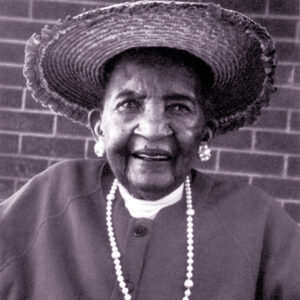calsfoundation@cals.org
Daisy Anderson (1900?-1998)
Educator, author, and lecturer Daisy Graham Anderson is best known for being one of the last surviving widows of the American Civil War (1861–1865), having been married to a former slave and U.S. Colored Regiment soldier and Union veteran. In 1998, she was inducted into the Arkansas Black Hall of Fame in Little Rock (Pulaski County).
Daisy Graham was born about 1900 in Civil District 8, Hardin County, Tennessee, to John Wesley Graham and Alice Graham. She was the oldest of the eight Graham children (three girls and five boys). Her father was a farmer. Even though he was poor, he owned his home. Education was stressed to the children—both Graham’s mother and father could read and write.
After graduating from the eighth grade, Graham sought to escape the hard labor and poor conditions of farming that she and her siblings were engaged in as children, especially the limited employment and racial strife. Around 1918, she moved to Arkansas, settling in Forrest City (St. Francis County) and becoming a rural schoolteacher. Living in Arkansas alleviated neither the poverty that had plagued her and her family nor the encounters with Jim Crow laws. Although she said that “things were even worse” around Forrest City than in Tennessee, after paying her monthly expenses, she would send $10 month to help her family in Tennessee.
In 1922, when she was in her early twenties, Daisy met and married Robert Ball Anderson, then seventy-nine years old. Anderson was on an extended visit with his older brother, William Anderson, when he met and married Daisy. She would later state, “He loved me, but I didn’t [love him] when I married him.”
Robert Anderson had been born in 1843 into slavery in Green County, Kentucky. In 1865, he enlisted in Company G of the 125th U.S. Colored Volunteer Infantry Regiment and served under the name Robert Ball (using his master’s last name). After his military service, which included a year at Fort Bliss, Texas, he later settled in Butler County, Nebraska. By the time he had made his way to Arkansas, Anderson was the richest black man in Nebraska, owning more than 2,000 acres of farmland.
In November 1930, Robert Anderson was killed in an automobile accident while returning to their homestead in Nebraska after a trip to Forrest City.
Daisy Anderson wrote a personal account of her husband’s life titled From Slavery to Affluence: Memoirs of Robert Anderson, Ex-Slave; it was privately published in 1927 and reissued in 1988. She would also take up one of Robert Anderson’s favorite activities—attending Grand Army of the Republic (GAR) reunions and other Civil War–related events. In 1997, Daisy Anderson (Union widow) and Alberta Martin (Confederate widow) would extend their hands toward one another at the wall of “Pickett’s Charge” in Gettysburg National Military Park, 134 years after that bloody struggle.
Daisy Graham Anderson died on September 19, 1998, in Denver, Colorado.
For additional information:
Anderson, Daisy. From Slavery to Affluence: Memoirs of Robert Anderson, Ex-Slave. Steamboat Springs, CO: Steamboat Pilot, 1988.
Florio, Gwen. “At 96, Widow of Civil War Soldier Finds She Is a Celebrity.” Philadelphia Inquirer, June 29, 1997. Online at http://articles.philly.com/1997-06-29/news/25528725_1_alberta-martin-confederate-widow-civil-war (accessed September 17, 2020).
Infield, Tom. “In Gettysburg, a Funeral, a Meeting and History. Handclasp Bridges 134 Years.” Philadelphia Inquirer, July 2, 1997. Online at http://articles.philly.com/1997-07-02/news/25549373_1_alberta-martin-william-jasper-martin-daisy-anderson (accessed September 17, 2020).
Thomas, Robert McG., Jr. “Daisy Anderson, 97, Widow of Former Slave and Union Soldier.” New York Times, September 26, 1998. Online at http://www.nytimes.com/1998/09/26/us/daisy-anderson-97-widow-of-former-slave-and-union-soldier.html (accessed September 17, 2020).
Wax, Darold D. “Robert Ball Anderson, Ex-Slave, a Pioneer in Western Nebraska, 1884–1930.” Nebraska History 64 (1983): 163–192.
Ronnie A. Nichols
North Potomac, Maryland
 Early Twentieth Century, 1901 through 1940
Early Twentieth Century, 1901 through 1940 Education, Elementary and Secondary
Education, Elementary and Secondary Military
Military Daisy Anderson
Daisy Anderson 




Comments
No comments on this entry yet.